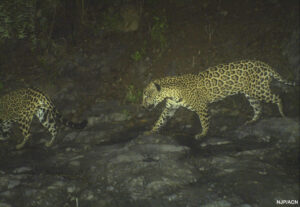The efforts made since 1990 by several conservation organizations for the conservation and conservation of the jaguar protection and its habitat in the state of Sonora The results are encouraging, as last May a female and her puppy were captured by a camera trap in the region of Sahuaripa.
This event is of vital importance because the female that was photographed, who was named Choki (star, in Yaqui language), had already been captured with her mother (Luisa) in 2020. Choki's offspring is the confirmation of a third generation of this feline within the Northern Jaguar Reserve.
This information was posted on the reserve's Facebook page.
"On May 11, a female jaguar with a cub was photographed in the Northern Jaguar Reserve. This four-year-old female had already been photographed in previous years and was named Choki. It is possible that this small cub, approximately two and a half months old, is Choki's first cub in her life," he notes.
It is worth mentioning that Choki was recognized by the pattern of its skin spots, which is unique to each individual and does not change throughout its life.
"On this occasion, Choki can be seen in the photos walking along one of the trails in the reserve during the afternoon of a warm day in May, closely followed by her little cub. At this age, the cub has finally left the den where it was born and begins to follow its mother in search of other shelters where it will remain while she feeds so that she can continue breastfeeding it until it can go out to hunt for food with her, at around five months of age," explains the environmental organization.
The Northern Jaguar Reserve explains that Choki has been a recurrent inhabitant of the reserve and it is known, through the use of automatic cameras, that she is the daughter of a female named Luisa, with whom she was detected in the summer of 2020 when she was beginning to become independent from her.
"And if we go back a little further, we can deduce that Choki was quite possibly the result of Luisa's union with a male named Elvis, when they were photographed together in the summer of 2018. Even with the uncertainty of the grandfather, the interesting thing about this case is that for the first time we know three generations in the reserve: Luisa (the grandmother), Choki (the mother) and her cub," he stresses.
A space for the life of the jaguar
The Northern Jaguar Reserve is an area of 24,000 hectares established by Naturalia A.C.. which serves for the protection and conservation of the jaguar and more than 300 native species of mammals, reptiles, amphibians and birds.
In efforts to conserve the largest feline in the Americas, cattle ranches neighboring the reserve are participating in the program. Living with FelinesThis is an even smaller but essential area within the territory of the northern jaguars in order to contribute to their conservation.
In the last 12 years, the Northern Jaguar Project has photographed eight jaguar cubs on the grounds of the reserve in the area of Sahuaripa.
The Northern Jaguar Reserve offers the young of these felines many hiding places where they can take refuge from threats, such as other male jaguars, pumas and coyotes. The trail through which they traveled on this occasion runs through one of the reserve's deep canyons; it is surrounded by dense, fairly dry scrub, except for some areas where mesquite, tepehuajes and tescalamas grow, which provide good shade at this time of year and where small but vital water runoffs for the wild animals emerge during the dry season.
The establishment and care of natural areas such as the Northern Jaguar Reserve is important because they are areas dedicated to the conservation of wild species, whose development is modified by human productive activities.
In this case, conservation actions are focused on the jaguar in the northernmost part of the species' natural distribution. In this region, in addition to the arduous environmental conditions, jaguars face other threats such as habitat destruction or modification and persecution due to alleged conflict with cattle ranching.
Conservation efforts include Northern Jaguar Project, Asociación Conservación del Norte, A.C. and Conciencia y Educación Ambiental, A.C.and inhabitants of the region.
Source: Northern Jaguar Reserve



